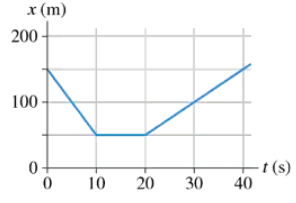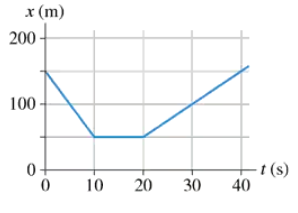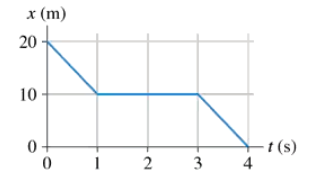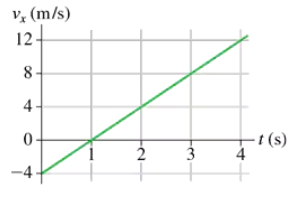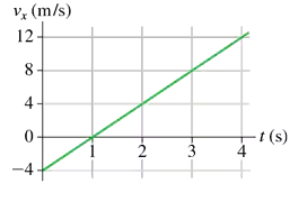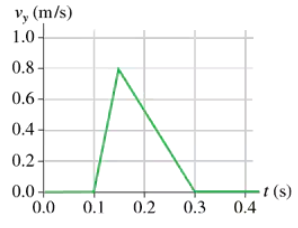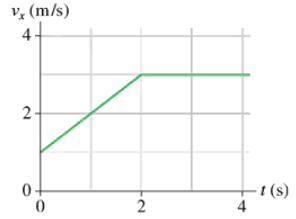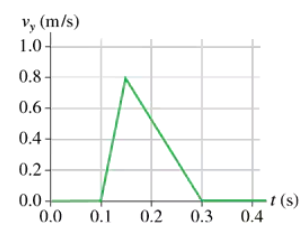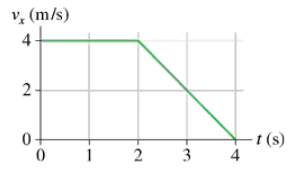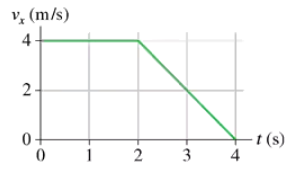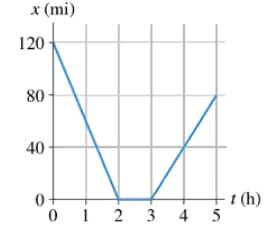 Back
BackProblem 1a
Larry leaves home at 9:05 and runs at constant speed to the lamppost seen in FIGURE EX2.1. He reaches the lamppost at 9:07, immediately turns, and runs to the tree. Larry arrives at the tree at 9:10. What is Larry's average velocity, in, during each of these two intervals?
Problem 1b
Larry leaves home at 9:05 and runs at constant speed to the lamppost seen in FIGURE EX2.1. He reaches the lamppost at 9:07, immediately turns, and runs to the tree. Larry arrives at the tree at 9:10. What is Larry's average velocity for the entire run?
Problem 2a
Julie drives 100 mi to Grandmother's house. On the way to Grandmother's, Julie drives half the distance at 40 mph and half the distance at 60 mph. On her return trip, she drives half the time at 40 mph and half the time at 60 mph. What is Julie's average speed on the way to Grandmother's house?
Problem 4a
FIGURE EX2.4 is the position-versus-time graph of a bicycle. What is the bicycle's velocity at t = 5s
Problem 4c
FIGURE EX2.4 is the position-versus-time graph of a bicycle. What is the bicycle's velocity at t = 30s?
Problem 5a
FIGURE EX2.5 shows the position graph of a particle. Draw the particle’s velocity graph for the interval .
Problem 6a
A particle starts from at and moves with the velocity graph shown in FIGURE EX2.6. Does this particle have a turning point? If so, at what time?
Problem 6b
A particle starts from x0 = 10 m at t0 = 0 s and moves with the velocity graph shown in FIGURE EX2.6. What is the object’s position at t = 2 s and 4 s?
Problem 8
FIGURE EX2.8 is a somewhat idealized graph of the velocity of blood in the ascending aorta during one beat of the heart. Approximately how far, in cm, does the blood move during one beat?
Problem 9a
FIGURE EX2.9 shows the velocity graph of a particle. Draw the particle's acceleration graph for the interval 0 s ≤ t ≤ 4 s.
Problem 11
FIGURE EX2.8 showed the velocity graph of blood in the aorta. What is the blood's acceleration during each phase of the motion, speeding up and slowing down?
Problem 12a
FIGURE EX2.12 shows the velocity-versus-time graph for a particle moving along the x-axis. Its initial position is at x0 = 2 m at t0 = 0 s. What are the particle's position, velocity, and acceleration at t = 1.0 s?
Problem 12b
FIGURE EX2.12 shows the velocity-versus-time graph for a particle moving along the x-axis. Its initial position is at x0 = 2 m at t0 = 0 s. What are the particle's position, velocity, and acceleration at t = 3.0 s?
Problem 13a
What constant acceleration, in SI units, must a car have to go from zero to 60 mph in 10 s?
Problem 13b
How far has the car traveled when it reaches 60 mph? Give your answer both in SI units and in feet.
Problem 14
A jet plane is cruising at 300 m/s when suddenly the pilot turns the engines up to full throttle. After traveling 4.0 km, the jet is moving with a speed of 400 m/s. What is the magnitude of the jet's acceleration, assuming it to be a constant acceleration?
Problem 16
When you sneeze, the air in your lungs accelerates from rest to 150 km/h in approximately 0.50 s. What is the magnitude of the acceleration of the air in m/s2?
Problem 17
A speed skater moving to the left across frictionless ice at 8.0 m/s hits a 5.0-m-wide patch of rough ice. She slows steadily, then continues on at 6.0 m/s. What is her acceleration on the rough ice?
Problem 18
A Porsche challenges a Honda to a 400 m race. Because the Porsche's acceleration of 3.5 m/s2 is larger than the Honda's 3.0 m/s2, the Honda gets a 1.0 s head start. Who wins? By how many seconds?
Problem 18b
FIGURE EX1.18 shows the motion diagram of a drag racer. The camera took one frame every 2 s. Make a position-versus-time graph for the drag racer. Because you have data only at certain instants, your graph should consist of dots that are not connected together.
Problem 20
Write a short description of the motion of a real object for which FIGURE EX1.20 would be a realistic position-versus-time graph.
Problem 20a
Ball bearings are made by letting spherical drops of molten metal fall inside a tall tower—called a shot tower—and solidify as they fall. If a bearing needs 4.0 s to solidify enough for impact, how high must the tower be?
Problem 20b
Ball bearings are made by letting spherical drops of molten metal fall inside a tall tower—called a shot tower—and solidify as they fall. What is the bearing's impact velocity?
Problem 21a
A rock is tossed straight up from ground level with a speed of 20 m/s. When it returns, it falls into a hole 10 m deep. What is the rock's speed as it hits the bottom of the hole?
Problem 23
As a science project, you drop a watermelon off the top of the Empire State Building, 320 m above the sidewalk. It so happens that Superman flies by at the instant you release the watermelon. Superman is headed straight down with a speed of 35 m/s. How fast is the watermelon going when it passes Superman?
Problem 24
When jumping, a flea accelerates at an astounding 1000 m/s2, but over only the very short distance of 0.50 mm. If a flea jumps straight up, and if air resistance is neglected (a rather poor approximation in this situation), how high does the flea go?
Problem 26
A car traveling at 30 m/s runs out of gas while traveling up a 10° slope. How far up the hill will it coast before starting to roll back down?
Problem 27a
A skier is gliding along at 3.0 m/s on horizontal, frictionless snow. He suddenly starts down a 10° incline. His speed at the bottom is 15 m/s. What is the length of the incline?
Problem 29
A bicycle coasting at 8.0 m/s comes to a 5.0-m-long, 1.0-m-high ramp. What is the bicycle's speed as it leaves the top of the ramp?
Problem 30b
A snowboarder glides down a 50-m-long, 15° hill. She then glides horizontally for 10 m before reaching a 25° upward slope. Assume the snow is frictionless. How far can she travel up the 25° slope?



